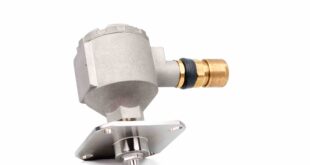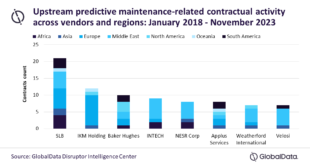A new industry report launched today – an extension of the global Technology Radar survey series produced by Lloyd’s Register (LR) – reveals the pace, development and adoption of predictive analytics in oil and gas.
The report brings in to focus how different companies are using predictive analytics and to what extent companies are transforming their own technology and data capabilities to predict a better performing and sustainable future between operators, service providers and technology makers.
Industry executives and other experts interviewed for this report have identified several fields of predictive and other advanced analytics application – and the industries where they are being used – that hold potential for oil and gas. The report indicates adoption is a reality now.
Key findings of the predictive analytics report include:
* 57 of the world’s 100 largest oil and gas firms are using, or have plans to use, predictive analytics.
* 34 of these 57 companies are using or have plans to use predictive analytics
* Companies using predictive analytics are benefiting by:
– $325,000 per rig using machine learning to predict drill-bit locations
– saving costs of $7 million on gas pipelines in eastern US through predicting failures
* Research proves predictive analytics are being tested and applied in:
– machine learning to improve safety improvement capabilities
– in unconventional wells to change management attitude
– behavioural modelling to reduce the frequency of safety incidents
– exploring fully automated drilling platforms
– automated analysis of subsurface data
– designing the ‘rig of the future’.
* Respondents believe Artificial Intelligence (AI) is unlikely to be applied beyond niche applications for another three years.
The research sought the insights and opinions of leaders across the sector, such as: Eric Abecassis CIO, Schlumberger, Stephen Ashley Manager, Digital Transformation Solution Centre, Oil & Gas Technology Centre, Willem van Asperen Director, applied artificial intelligence, PA Consulting Group, Richard Barclay Manager, Advanced analytics, ConocoPhillips, Margery Connor Leader, Data science capability and Technology, Chevron, Daniel Jeavons General manager – data science, Shell, Michael Jones Senior director of strategy and M&A, Halliburton Digital Solutions, Adam Judelson Founder and CEO, Cognotient, Neil Kavanagh Chief science & technology manager, Woodside Petroleum, Narayan Laksham Founder and CEO, 4casting Systems, Joel Meltzner CEO and president, i4 Insight, and Morten Møller Pedersen Deputy asset manager, Maersk Drilling.
“This report makes clear that the oil and gas industry still has much to do to lay a solid foundation for using predictive technologies effectively,” says Nial McCollam, Chief Technology Officer of LR. “Companies will do this by solving data quality and standardisation issues, and establishing the external relationships that will give them access to the large volumes of data they need.”
Making the most of data requires more than advanced analytics tools and skilled data scientists. The report reinforces the fundamental need to successfully collect and transmit data to help with better decision making.
McCollam says: “Recent advances in data analytics technologies – predictive analytics in particular – and networked sensors offer companies the opportunity to greatly widen and systematize the scope of their forecasting to include operational processes up and down the value chain.”
Adoption: a myth or a reality?
Contributors to the report highlight the critical areas for predictive analytics including demand forecasting, oil and gas trading, spare parts inventory management, transport route optimisation, process control and facility management.
“The Technology Radar report finds that many of the industry’s largest companies are actively developing predictive capabilities using internal and external resources,” says McCollam. “At least one-third of the top 100 industry players by size are generating a beneficial impact from using this technology. Sure, there is a long way to go, but adoption and new ways of thinking and working is becoming a reality.”
By using large volumes of historic seismic and production data, existing and new sensors, and powerful algorithms, companies have unlocked insights not previously available to them, which has boosted efficiency and productivity, reduced downtime, and earned them demonstrable returns along the way.
Unconventional wells, mainly in North America, have been the biggest early beneficiaries of predictive analytics to date.
What does the future hold?
Predictive analytics are now coming to bear in asset maintenance – human and equipment.
McCollam says: “Foreseeing and preventing events that lead to injury, loss of life or environmental damage is a key part of predictive analytics – and even more so in driving efficiencies and enhancing performance.”
“The ability to predict erosion and lifespans of equipment such as drills, pumps and other rig equipment promises considerable savings. And we are also seeing companies begin to experiment with predictive analytics in behavioural modelling to help identify symptoms of unsafe human behaviour, and predicting when certain behaviour traits are likely to create high-risk situations.”
“Along with our clients and partners, we believe that the use of predictive analytics can lead to both improved performance and enhanced safety and better risk management. Encouragingly, the findings of this special edition of the LR Technology Radar show that this potential is beginning to convert into reality.
The report highlights how the experience of predictive analytics used in consumer markets can provide better insights in to how more accurate predictions are generated when multiple sets of data from different sources are layered up.
“Distilling these lessons can only help oil and gas companies to adapt using cases perfected elsewhere, and inspire us to develop innovative ones of our own. However, the report also highlights that governments, regulators and industry leaders have a critical part to play by fostering environments in which oil and gas companies can share data with confidence, and without fear that the data that is shared will be tuned against them from an environmental performance or safety perspective.”
This is the fourth year LR has conducted its award-winning Technology Radar research. Whilst earlier editions have focused on macro energy insights of the oil and gas sector and low carbon power generation, this time around, the research concentrates on predictive analytics in oil and gas, with a focus on operation performance, safety, technology, analytics design, machine learning, human behaviour, policy, safety, public appetite and acceptance.
The 2018 Technology Radar Oil & Gas report is available HERE.
 Engineer News Network The ultimate online news and information resource for today’s engineer
Engineer News Network The ultimate online news and information resource for today’s engineer


